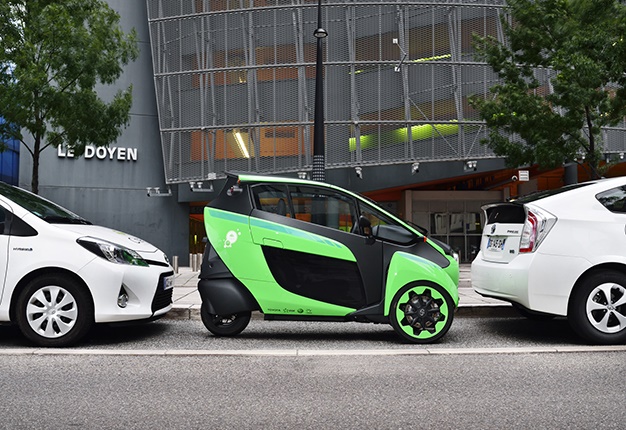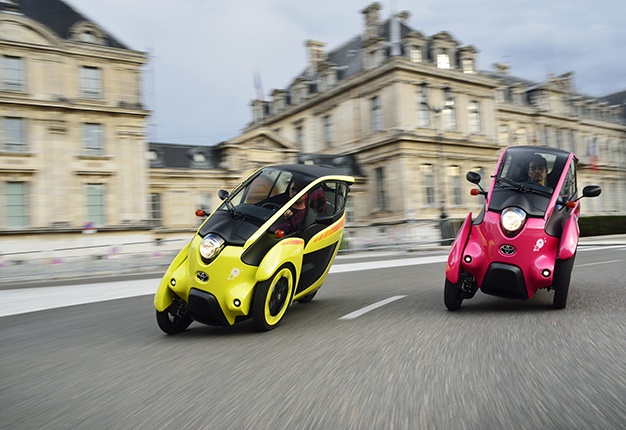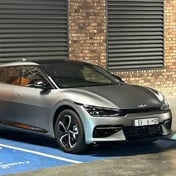
First shown in concept form at the 2013 Geneva motor show Toyota’s personal mobility vehicle (PMV) the i-Road has been transformed into a road-legal version – capable of circumventing city congestion and creating enhanced mobility.
PMVs are a new, more flexible type of transport for urban driving that is significantly more comfortable, weatherproof, stable and safe than scooters and motorcycles.
Personal mobility
While they share the zero-emissions and low running cost virtues of electric vehicles, their dimensions – in particular, their width – are similar to a conventional two-wheeler, giving them the essential manoeuvrability needed for negotiating city traffic and easy parking.
READ: Toyota reveals all-new Quantum due in SA later this year
For the first time, the i-Road vehicle has touched down on African soil – as part of a personal mobility demonstration at Toyota’s State of the Motor Industry (SOMI) address held in Midrand, Gauteng.
Toyota has refined the design of the original i-Road concept to improve visibility, weatherproofing, manoeuvrability and general user-friendliness.
The doors have gained manually operated windows, making i-Road completely weatherproof and giving it a considerable advantage over conventional two-wheelers in that it can be driven without a helmet or protective clothing in all weather conditions.
The rear has been redesigned with a reduced overhang, restyled and repositioned combination lamps and a small rear window. There is a choice of five bright colours for the bodywork.
Active Lean technology and rear-wheel steering
The revised Toyota i-Road measures 2 345m long, 1 455mm high and 870mm wide, and has a 1 695mm wheelbase. This makes it 5mm shorter than the concept, 10mm higher and 20mm wider – dimensions that remain ultra-compact.
This means it can be driven smoothly along roadsides and down narrow alleys. Up to four i-Road can be parked in a single standard parking bay.
The full electric powertrain is unchanged: a lithium-ion battery powers a pair of 1.9kW electric motors mounted in the front wheels.
With brisk acceleration and near-silent running, i-Road has a driving range of around 50km (target distance at a fixed 30km/h). A full recharge from a conventional household power supply takes just three hours.
Image: Motorpress
Toyota’s new, entirely intuitive Active Lean technology is key to i-Road’s higher levels of stability, safety, comfort and enjoyment.
Working in conjunction with rear-wheel steering, controlled by a conventional steering wheel, the system has a lean actuator motor and gearing mounted above the front suspension member and linked via a yoke to the left and right front wheels.
An ECU calculates the required angle of lean, based on steering angle, vehicle speed and information from a gyro sensor.
Image: Motorpress
The system automatically moves the wheels up and down, in opposite directions, and can apply a lean angle to counteract the centrifugal force of cornering.
The system also operates when i-Road is being driven straight ahead on a stepped surface, the lean actuator automatically compensating for changes in the road surface to keep the body level.
Active Lean technology gives a unique driving experience, with all the enjoyment of two-wheeler riding, exceptional manoeuvrability and a minimum turning circle of just three metres, yet with no need for the driver to keep the vehicle stable at low speeds, or when stationary.
Image: Wheels24
The fact the driver doesn’t have to put his or her feet on the road surface at any time allows i-Road to have a safer, weatherproof, closed body construction.
Not only does this mean the driver doesn’t have to wear a helmet, but there is also a more car-like environment inside, with the opportunity to install heating, an audio system and Bluetooth.
Urban transport of the future became a reality in the French city of Grenoble, where a partnership between Toyota, the local authorities, EDF, Sodetrel and Cité-lib conducted a three-year trial targeting improvements in the efficiency and effectiveness of public transport systems by interconnecting them with electric PMVs.
Toyota supplied 35 i-Road (and 35 four-wheeled electric COMS vehicles) to the project and contributed its Ha:Mo (harmonious mobility) system to manage the scheme day-to-day, following a model that’s already been successfully trialled in Toyota City in Japan.




 Publications
Publications
 Partners
Partners













